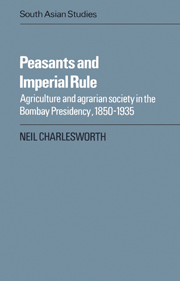Book contents
- Frontmatter
- Contents
- List of maps and tables
- Preface
- Note on technical terms and references
- Maps
- 1 Introduction: the peasant in India and Bombay Presidency
- 2 The village in 1850: land tenure, social structure and revenue policy
- 3 The village in 1850: land and agriculture
- 4 Indebtedness and the Deccan Riots of 1875
- 5 Continuity and change in the rural economy, 1850–1900
- 6 The Bombay peasantry, 1850–1900: social stability or social stratification?
- 7 The agricultural economy, 1900–1935: the critical watershed?
- 8 The impact of government policy, 1880–1935
- 9 The peasant and politics in the early twentieth century
- 10 Conclusions: the problem of differential commercialisation
- Glossary
- Bibliography
- Index
8 - The impact of government policy, 1880–1935
Published online by Cambridge University Press: 10 December 2009
- Frontmatter
- Contents
- List of maps and tables
- Preface
- Note on technical terms and references
- Maps
- 1 Introduction: the peasant in India and Bombay Presidency
- 2 The village in 1850: land tenure, social structure and revenue policy
- 3 The village in 1850: land and agriculture
- 4 Indebtedness and the Deccan Riots of 1875
- 5 Continuity and change in the rural economy, 1850–1900
- 6 The Bombay peasantry, 1850–1900: social stability or social stratification?
- 7 The agricultural economy, 1900–1935: the critical watershed?
- 8 The impact of government policy, 1880–1935
- 9 The peasant and politics in the early twentieth century
- 10 Conclusions: the problem of differential commercialisation
- Glossary
- Bibliography
- Index
Summary
In carrying forward the story of the agricultural economy's evolution down to 1935, we have, however, omitted any consideration of one possibly vital influence: the role of the state and its policies. In 1880, with the Deccan Agriculturists' Relief Act, the Bombay government had just assumed new powers to influence rural economic relationships in the four central Deccan districts to add to its traditional prominent role within the village as an arbiter of land rights and the beneficiary of land revenue. The Deccan Act, as we saw, was a complex measure and its impact may have been highly consequential, not necessarily in the manner intended. At the same time, it could hardly set a final seal on debate over agrarian reform. The range of developments we have described, particularly tenurial changes and those in the organisation of land, provided a further challenge to policy. Motives would involve not only the inevitable security fears aroused by the apparent tenurial revolution recorded in the revenue papers and census material. Even if tenurial changes were regarded in sanguine vein as the product of a more fluid system, they still carried the danger of destroying that direct administrative contact with and knowledge of the cultivating peasantry which was the ryotwari system's special claim. In a simple technical sense, too, the changes in land organisation developing in the early twentieth century made nonsense of the revenue department's intricate survey maps. So we might expect further calls to reform and legislative action, like those which had proved so successful in the 1870s.
- Type
- Chapter
- Information
- Peasants and Imperial RuleAgriculture and Agrarian Society in the Bombay Presidency 1850–1935, pp. 239 - 267Publisher: Cambridge University PressPrint publication year: 1985

